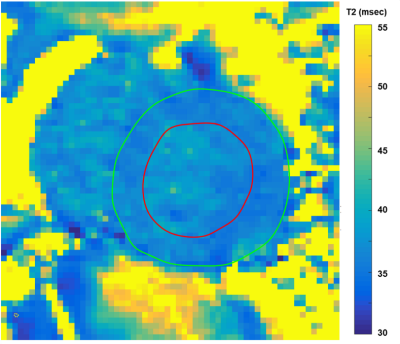1116
Consistent and Accurate 3T Cardiac End-Systolic Adiabatic T2-Mapping1MRI Research Center, Auburn University, Auburn University, AL, United States
Synopsis
Cardiac T2-mapping is ideal for assessing myocardial edema resulting from events, such as, acute myocardial infarction, myocarditis and tako-tsubo cardiomyopathy. While many T2mapping sequences exist, most have design shortcuts that degrade their consistency, accuracy and prognostic value. T2maps captured at end-systole (ES) have maximum wall thickness and fewest artifacts and 4-point T2 curve-fits provide good T2 estimates. We present an Adiabatic T2-Prep Mapping sequence that produces accurate 4-point T2maps at ES within a 22-second breath hold at 3T. Pretesting on phantoms and in vivo validation on healthy human volunteers presented superior results.
Introduction
Cardiac MRI (CMR) T2-mapping is needed to assess myocardial edema after such events as acute myocardial infarction, myocarditis and tako-tsubo cardiomyopathy [1]. CMR must also provide maximum diagnostic information with minimum operator effort, time and cost [2]. Many T2mapping sequences exist, but most sequence designs have performance-reducing shortcuts including: 1) Imaging during end-diastole (ED) to produce left ventricle (LV) T2maps of the thinnest transmural wall thickness and during highest wall motion. 2) Acquire only three T2 imaging time-points that give poor T2 3-point curve fits. 3) Include a poorly justified no-T2prep, time-zero point that further corrupts the 3-point T2 curve-fit. All these features effectively shorten the scan time, but they also degrade the consistency, accuracy and prognostic value of the T2map results. CMR T2mapping is needed that avoids these shortcomings and can still be a fast scan. Ideally, T2maps generated at, or soon after, end-systole (ES) present maximum wall thickness, minimum wall motion, and minimum interventricular blood pool size to reduce partial-volume and other artifacts at the LV epi and endocardial boundaries. True 4-point T2maps also provide higher accuracy T2 curve-fit results. We developed a x4-accelerated sequence that produces accurate 4-point T2maps at ES within a 22-second breath hold at 3T. The T2 accuracy was verified in phantom tests and the overall performance demonstrated on three healthy volunteers.Methods
A prospectively ECG-triggered sequence with an adiabatic T2prep module and ramped flip angle readout module with GRAPPA was developed for use at 3T (see Figure 1). The readout module acquires four successive images as a mini-cine and was selectable for balanced steady-state (bSSFP) or fast low-angle shot (FLASH) methods. The T2prep module includes hard-rect (flip-down/up) and adiabatic (refocussing) RF pulses with CPMG phase-weighting [3]. This T2prep method was ideal since it stored the T2-prepared magnetization in the longitudinal axis until the delayed readout. The T2prep module was R-wave triggered and a selectable time-delay placed the readout of four image frames to run at or just after LV ES. T2 accuracy tests were run on a CuSO4-doped agar phantom and compared to gold-standard T2 spin-echo (SE) results on the same phantom. In vivo test scans were completed on three healthy volunteers with informed consent. All scans were run on a Siemens 3T Verio scanner (Siemens, Erlangen, Germany) with a 32-chan anterior/posterior RF coil array (Invivo, Gainesville, Florida). All image, curve-fitting, and mapping analysis was performed offline with custom Matlab programs (Mathworks, Natick, MA). The T2Prep image at the shortest TE time (TEmin=14ms), with highest blood/tissue contrast, was used to manually segment the LV epi and endocardial boundaries, thereby defining the total LV myocardial ROI for the resulting T2map. These ROI were processed by Neider-Mead Simplex Method to per-pixel curve-fit the 4 T2 time points into T2maps, mean, and standard deviation within the slice and across the three volunteers.Imaging parameters: T2prep TE times = 14, 28, 42, 56 ms; T2prep to Readout Delay = 0.33 x ECG RR (typically 280 ms); FOV = 264x246 mm; Pixel size = 2.75x2.75 mm; Matrix = 96x96 (interpolated to 128x128); Slice thickness = 8 mm; GRAPPA accel factor = 4; Flip angle = 35°/10° (bSSPF/FLASH); TE = 1.63 ms, TR = ECG RR (typically 850 ms); Bandwidth = 1048 Hz/Pixel; Averages = 1. For human subjects: three mid-LV, short-axis, T2map slices, 8 mm spacing gap, sequentially positioned and scanned.
Results
Preliminary T2 measurements on the agar phantom gave T2 = 40.9±1.5 ms and 42.7±3.1 ms (Mean±StdDev) respectively for the T2 SE versus T2prep. Assuming T2 SE as the accurate reference, this made the T2prep result a +4.4% higher (error). All human volunteers completed successful T2prep mapping scans with three slices per subject for a total of nine slices. Each T2map was acquired within a maximum 22 second breath hold. Figure 2 presents result T2prep images at the four T2 times where the image magnitudes shows the expected decline as T2prep time increased. Figure 3 presents a representative result mid-LV T2map image with LV segmentation lines (green and red) transferred after being drawn on a T2Prep TEmin=14 ms image. The maps showed good consistency and minimal “bad” mapping pixels. The three-slice mean T2 results for the three volunteers were 42.4±6.1, 38.9±10.4 and 39.9±8.6 ms and the overall total mean for all nine slices from all three volunteers was 40.4±8.6 ms.Discussion
The phantom T2 accuracy as +4.4% higher than SE are acceptably close to validate this adiabatic T2prep method. The presented in vivo T2maps with thickened LV walls at ES were easier to segment and inspect compared to thin-walled ED maps. Interestingly, the T2prep in vivo overall mean T2 result of 40.4±8.6 ms in healthy volunteers is lower than the in vivo 50-55 ms range reported by previous literature.Conclusions
This adiabatic T2prep CMR T2mapping sequence creates sufficiently accurate and consistent T2maps at end-systole with a 22 second breath hold. This may provide improved prognostic value.Acknowledgements
Special thank you for project support goes to Julie Rodiek, Steven Nichols and Adam Davila.References
1. Giri S, et al T2 quantification for improved detection of myocardial edema, JCMR 2009; 11(56).
2. Edelstein WA, et al “MRI: Time Is Dose—and Money and Versatility”, J Am Coll Radiol 2010;7(8): 650–2.
3. Beyers RJ, et al T2-weighted MRI of post-infarct myocardial edema in mice, MRM 2012; 67(1)
Figures


